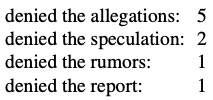Generalization and Zeros
The n-gram model is dependent on the training corpus (like many statistical models).
Implication:
- The probabilities often encode specific facts about a given training corpus.
- n-grams do a better and better job of modeling the training corpus as we increase the value of .
Notice when building n-gram models:
use a training corpus that has a similar genre to whatever task we are trying to accomplish.
- To build a language model for translating legal documents, we need a training corpus of legal documents.
- To build a language model for a question-answering system, we need a training corpus of questions.
Get training data in the appropriate dialect (especially when processing social media posts or spoken transcripts)
Handle sparsity
When the corpus is limited, some perfectly acceptable English word sequences are bound to be missing from it.
We’ll have many cases of putative “zero probability n-grams” that should really have some non-zero probability!
Example:
Consider the words that follow the bigram denied the in the WSJ Treebank3 corpus, together with their counts:

But suppose our test set has phrases like:
denied the offer denied the loanOur model will incorrectly estimate that the is 0! 🤪
Zeros: things that don’t ever occur in the training set but do occur in the test set
🔴 Problems
We are underestimating the probability of all sorts of words that might occur, which will hurt the performance of any application we want to run on this data.
If the probability of any word in the test set is 0, the entire probability of the test set is 0.
Based on the definition of perplexity, we can’t compute perplexity at all, since we can’t divide by 0!
Unknow words
Closed vocabulary system:
- All the words can occur
- the test set can only contain words from this lexicon, and there will be NO unknown words.
- Reasonable assumption in some domains
- speech recognition (we have pronunciation dictionary in advance)
- machine translation (we have phrase table in advance)
- The language model can only use the words in that dictionary or phrase table.
Unknown words: words we simply have NEVER seen before.
- sometimes called out of vocabulary (OOV) words.
- OOV rate: percentage of OOV words that appear in the test set
Open vocabulary system:
- we model these potential unknown words in the test set by adding a pseudo-word called
<UNK>.
Two common ways to to train the probabilities of the unknown word model <UNK>
Turn the problem back into a closed vocabulary one by choosing a fixed vocabulary in advance
Choose a vocabulary (word list) that is fixed in advance.
Convert in the training set any word that is not in this set (any OOV word) to
the unknown word token
<UNK>in a text normalization step.Estimate the probabilities for
<UNK>from its counts just like any other regularword in the training set.
We don’t have a prior vocabulary in advance
Create such a vocabulary implicitly
Replace words in the training data by
<UNK>based on their frequency.- we can replace by
<UNK>all words that occur fewer than times in the training set, where is some small number, or - equivalently select a vocabulary size in advance (say 50,000) and choose the top words by frequency and replace the rest by
<UNK>
In either case we then proceed to train the language model as before, treating
<UNK>like a regular word.- we can replace by